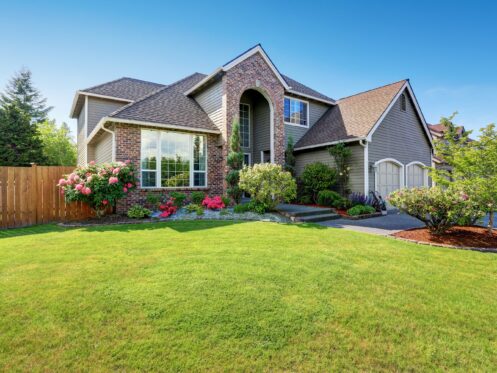Your Georgia home’s roof absorbs significant solar energy during the daytime hours, and that excess heat can cause you many problems in the short term as well as in the future. The purpose of a cool roof is to reflect much more sunlight than a traditional roofing material. Modern cool roofs not only have high solar reflectance but high thermal emittance. That allows them to shed heat by emanating thermal infrared radiation. Cool roofing materials cost somewhat more than conventional materials, but the added benefits of cool roof replacement are well worth it in the long run. Let’s explore the reasons why.
Enhanced Home Comfort
During a hot and sunny day, your roof can reach temperatures as high as 150 degrees Fahrenheit. In those same conditions, a roof with high thermal emittance and solar reflectance would remain about 50 degrees cooler. Your roofing system is an integral aspect of your house’s building envelope, and when the roof is hotter, the air in the attic is as well. That makes it more difficult to achieve a cooler home. With a cool roof, you’ll reach your comfortable temperature setting sooner and maintain it more easily. You’ll also achieve more even cooling throughout the house.
Better Indoor Air Quality
There’s a direct relationship between your home’s building envelope and indoor air quality. A cool roof helps to improve air quality in several ways. The reflectance and emittance slow the formation of smog around the roof. Those are particles that otherwise can enter your home through passive and mechanical ventilation. In addition, the attic is cooler with a cool roof. Warmer air is more stagnant, which can lead to increased pollutant concentration levels.
Lower Cooling Costs
A house can experience as high as a 25% heat transfer between the roof and the living space. Having a roof that is around 50 degrees cooler can make a dramatic difference. Industry studies indicate that the annual energy bill savings will be at least 10% for most homes, and some homes can achieve savings as high as 30% with a cool roof. Another consideration is that a cool roof lowers peak energy demand. During the hottest part of the day, your roof absorbs more energy. Your air conditioner is running harder and longer, and this is a time when electricity rates are higher. Lowering usage during peak demand saves you money and helps avoid power outages.
Smaller Carbon Footprint
A cool roof is better for the environment and lowers your household’s carbon footprint. By lowering your demand during peak periods you’re reducing the greenhouse gas emissions of your provider. It helps decrease global warming by reflecting more sunlight into the atmosphere. Studies show that if every home had a cool roof, this effect would significantly reduce global warming. Running your AC less often matters as well, as air conditioning is the biggest contributor to many households’ carbon footprint.
Reduced Wear and Tear
It’s not just that you’re spending less money on cooling, the system won’t cycle as often. Cycling on and off is a significant contributor to AC wear and tear. During a cycle, there’s wear and tear to the condenser pump, condenser fan, blower, and other components. Your system will still need annual maintenance, but it’ll be less prone to repairs. Less wear and tear will also extend the life of the equipment and reduce your total cost of ownership.
Less Cooling Output Needed
HVAC installers size ACs through a load calculation that takes into account square footage, ceiling heights, and floor plan. It also factors in the building envelope, including the roof. That calculation provides the cooling output you need. A cool roof will lower the necessary cooling output, which has a couple of implications. You can continue to run an older AC longer than you would have without the cool roof. In addition, when it comes time to replace your AC, you can downsize to a more affordable unit.
Longer Roof Longevity
Heat is the number one contributor to the degradation of roofing materials. By reflecting sunlight, cool roofing shingles avoid absorbing substantial heat that would otherwise compromise the asphalt, felt, and underlayment. The reduced degradation is why cool roofing materials last longer than similar materials without those added features. You can see this longer expected lifespan reflected in the length and coverage of cool roof manufacturer warranties.
Less Roof Maintenance
A cool roof will generally need less maintenance than a traditional one. That’s because there’s less thermal stress on shingles, underlayment, flashing, ventilation, and components. Cool shingles are less prone to balding, which is where they lose their granules over time. They’re also less likely to loosen, curl up, and split. Despite needing less maintenance, you should still schedule an annual inspection and then take care of any issues that are revealed.
Reduce the Heat Island Effect
By reflecting heat into the atmosphere, a cool roof helps to avoid the heat island effect. You may see it referred to as the urban heat island effect, but it isn’t exclusive to cities. It can occur in suburban neighborhoods as well. Neighborhood design can limit airflow in the area and cause heat to become trapped near the ground. This results in a neighborhood that’s hotter than the ambient temperature would be normally. If all the homes in a subdivision have a cool roof, the combined solar reflection will avoid that effect.
Federal Tax Credit
The Energy Efficient Home Improvement Credit is a nonrefundable federal tax credit available to homeowners who make energy-efficient home upgrades. It specifically requires the installation of ENERGY STAR products. The U.S. EPA doesn’t give this certification to many roofing products, but cool roofing shingles are an exception. If eligible, you can claim 30% of the total installation costs up to $1,200.
Rebates and Other Energy Incentives
There may be rebates and other incentives to lower your costs even more. Check the ENERGY STAR website for rebates available in your area. Contact your local utilities to learn about other offers as well.
Code Compliance
Roof replacements typically require a permit. If a home improvement needs a permit, it has to be up to code to pass the inspection. Some jurisdictions have added cool roof requirements to their regulations, and they are most common with low-pitch roofs. That means you may not need cool shingles for the entire home.
Install a Cool Roof in Georgia
Fraser Roofing, LLC is a family-owned and operated roofing contractor in Georgia. We have multiple locations throughout the state, including Atlanta, Conyers, Lilburn, Newnan, Smyrna, and Statesboro. Our company has a local, trusted storm damage team available 24/7 for emergencies. We perform all roofing services such as new roof installations and replacements, including asphalt shingles, metal roofing systems, and eco-friendly green roofs. You can count on us for inspections, maintenance, and repairs. Our team also performs seamless gutter installation and replacement.
Call today or contact us online to learn more about the services and roofing products we offer.

